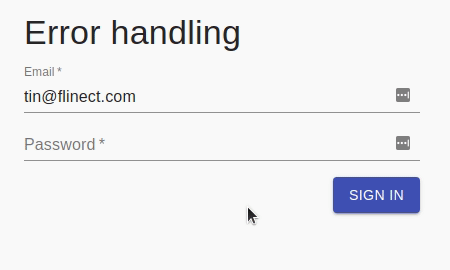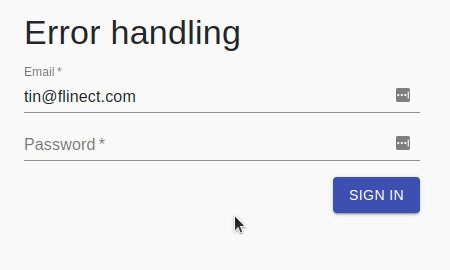Error Handling Pattern with React and Redux-Saga
This blog post is more than 6 months old and may contain outdated information.
1/6/2021
This article describes an error handling pattern with React and Redux-Saga.
Here's a pattern I've been using to deal with failure states on request/response type actions when using Redux with Redux-Saga.
Source code is available on GitHub.
Action transactions
We need a way to track state across request and response actions.
Let Transaction class hold the state of a transaction, which can be in progress, end in failure, or end successfully.
export class Transaction {
private constructor(
private readonly _started: boolean,
private readonly _done: boolean,
public readonly error?: ActionError,
) {}
public get ok(): boolean {
return this._started && this._done && !this.error;
}
public static create(): Transaction {
return new Transaction(false, false);
}
public static start(): Transaction {
return new Transaction(true, false);
}
public static finish(error?: ActionError): Transaction {
return new Transaction(true, true, error);
}
}We also declare the result type.
export enum ErrorCode {
IncorrectCredentials = 1,
}
export type ActionError = {
code: ErrorCode;
message: string;
};
export type ActionResult<T> =
| { error: ActionError }
| ({ error: undefined } & T);Additionally, Transaction class could hold any other response data, such as status or HTTP headers.
Redux actions
As an example, let's declare two types of Redux actions. One for making a request, and another that holds its result.
export enum UserActionType {
SignIn = 'user/sign-in',
SignInResult = 'user/sign-in-result',
}
export type SignInUserAction = {
type: UserActionType.SignIn;
payload: {
email: string;
password: string;
};
};
export type SignInResultUserAction = {
type: UserActionType.SignInResult;
payload: ActionResult<UserData>;
};
export type UserAction = SignInUserAction | SignInResultUserAction;Here are creator functions for these actions.
export const userActions = {
signIn: (email: string, password: string): SignInUserAction => ({
type: UserActionType.SignIn,
payload: { email, password },
}),
signInResult: (result: ActionResult<UserData>): SignInResultUserAction => ({
type: UserActionType.SignInResult,
payload: result,
}),
};Redux reducer
The state contains a transaction object for each request.
export type UserState = {
currentUser?: UserData;
signInTransaction: Transaction;
};
const initialState: UserState = {
signInTransaction: Transaction.create(),
};Here are some helper selectors for the user's state.
export const userSelectors = {
currentUser: (state: AppState): UserData | undefined =>
state.user.currentUser,
signInTransaction: (state: AppState): Transaction =>
state.user.signInTransaction,
};We need to handle SignIn and SignInResult actions and update the transaction state accordingly.
export default function userReducer(
state: UserState = initialState,
action: UserAction,
): UserState {
switch (action.type) {
case UserActionType.SignIn:
return { ...state, signInTransaction: Transaction.start() };
case UserActionType.SignInResult:
if (action.payload.error) {
return {
...state,
signInTransaction: Transaction.finish(action.payload.error),
};
} else {
return {
...state,
currentUser: action.payload,
signInTransaction: Transaction.finish(),
};
}
default:
return state;
}
}Upon failure, signInTransaction will contain the error object.
Saga
We'll perform the sign-in request on SignIn action and redirect to a home page on successful SignInResult action.
export function* userSaga(): Generator {
yield all([
takeLatest(UserActionType.SignIn, handleSignIn),
takeLatest(UserActionType.SignInResult, handleSignInResult),
]);
}The important part is to dispatch SignInResult action with appropriate ActionResult<UserData> payload.
Handling could involve calling the API within a try-catch block, and setting result's error property on failure.
function* handleSignIn(action: SignInUserAction): Generator {
const { email, password } = action.payload;
const user: UserData = { id: '1', email: '[email protected]' };
if (email != user.email || password != '123456') {
yield put(
userActions.signInResult({
error: {
code: ErrorCode.IncorrectCredentials,
message: 'Incorrect credentials.',
},
}),
);
return;
}
yield put(userActions.signInResult({ error: undefined, ...user }));
}We handle SignInResult separately.
function* handleSignInResult(action: SignInResultUserAction): Generator {
if (!action.payload.error) {
yield call(history.push, routerPaths.errorHandlingHome);
}
}Hooking up
In a component, we get the state for signInTransaction.
const ErrorHandlingPattern: React.FC = () => {
const dispatch = useDispatch();
const signInTransaction = useSelector(userSelectors.signInTransaction);
const signInError = signInTransaction.error;
// ...
};Then display possible error message.
// ...
{
signInError && <Alert severity="error">{signInError.message}</Alert>;
}
// ...And dispatch the SignIn action when the user clicks the "sign in" button.
// ...
const handleSubmit = (event: FormEvent): void => {
event.preventDefault();
dispatch(userActions.signIn(email, password));
};
// ...Sometimes you're dealing with dialogs that need to stay open on failure, or close on success.
This can be achieved by closing the dialog if transaction is successful (signInTransaction.ok).
If dialog displays an error and is closed, the ResetTransactions ensures that previous error is cleared before showing it again.
useEffect(() => {
if (signInTransaction.ok) {
setSignInDialogOpen(() => false);
dispatch(userActions.resetTransactions());
}
}, [signInTransaction]);Conclusion
Here's an example of entering incorrect credentials.
 Sign in with error
Sign in with error
If sign-in succeeds, user is redirected as expected.
 Successful sign in
Successful sign in
Source code is available on GitHub.
1/6/2021